The target should not be 1.5°C; rather we should aim for a safe climate. James Hansen told us in 2007 that to achieve a safe climate we need to bring GHG concentrations down to 350 ppm as soon as possible. That’s CO2 equivalent, not CO2. Current CO2e is not often quoted, but would be around 500 ppm on the basis that CO2 is about 80% of total GHGs. Also we need to focus on what we are doing to the planet over centuries and millennia, not just the next 50 to 100 years.
However, the IPCC team putting the report together were not asked what the goal should be. They were asked to build a scenario for achieving the 1.5°C warming limit specified as desirable in the Paris Agreement of 2015, and to look at the impacts of a 1.5°C world as against a 2°C world. Two Degrees came out of Europe in the 1990s, achieved a general currency, then became the official goal of at the Conference of Parties of the UNFCCC in Cancun in 2010. At that time there was a move mainly by many of the island states vulnerable it inundation for a more ambitious target. Essentially the whole group at Paris agreed to try.
However, while two degrees was commonly seen as a guardrail for a safe climate even by many scientist, it was never a scientifically derived goal for a safe climate.
The IPCC Special Report on 1.5°C is important because it shows that the path to 1.5°C has a high degree of difficulty and has implications which to most will not be acceptable. It’s importance is in changing the discourse, from being seen as an achievable safe guardrail to 1.5°C as difficult to achieve and far from safe.
I’ll give a short overview, then a summary of Gavin Schmidt’s response, then address some issues under specific headings.
Overview
When the UNFCCC decided to target 1.5°C there was little scientific literature on the subject, because all the focus had been on 2°C. However, scientists got busy and, from the media release, over 6,000 scientific papers were cited in the report, from 91 authors from 40 countries.
They consider that global net human-caused emissions of carbon dioxide (CO2) would need to fall by about 45% from 2010 levels by 2030, reaching ‘net zero’ around 2050. In energy, they see perhaps 2% coming from coal and very little from gas. Oil and fuel may still be used, but there would need to be carbon sinks to offset any such usage, as well as to offset methane from livestock and any other unavoidable emissions.
They foresee some 14 to 18 million square kilometres being set aside to grow trees to absorb carbon. Australia is 7.7 million sq km.
They have plotted a range of scenarios. The best offerings give only a 50% chance of staying within 1.5°C. Other scenarios involve “overshoot”. So if we want a better chance of staying within 1.5°C, or if we overshoot, then more atmospheric carbon will have to be removed and sequestered.
Unfortunately:
- The effectiveness of such techniques [is] unproven at large scale and some may carry significant risks for sustainable development, the report notes.
Unfortunately also:
- Coral reefs would decline by 70-90 percent with global warming of 1.5°C, whereas virtually all (> 99 percent) would be lost with 2°C.
To most of the original proponents of a target more ambitious than 2°C this should be unacceptable and a deal breaker.
They say, as Hurricane Michael bears down on the Florida coast, possibly the strongest ever:
- “One of the key messages that comes out very strongly from this report is that we are already seeing the consequences of 1°C of global warming through more extreme weather, rising sea levels and diminishing Arctic sea ice, among other changes,” said Panmao Zhai, Co-Chair of IPCC Working Group I.
In “among other changes” add bushfires, or wildfires as they are called elsewhere, which have appeared in the Arctic circle and California in winter.
The Climate Council’s acting CEO, Dr Martin Rice, has called a 1.5°C world “our best possible future”. I would hope that policy makers, looking at a likely 1.5°C world, might think that the impacts and risks are unacceptable and decide to target a 350 ppm world, even if that means putting the economy on a war footing.
The Climate Council has prepared The good, the bad and the ugly: Limiting temperature rise to 1.5°C to put into context what this means for Australia. I recommend the Climate Council report, while sounding a caution about burnable carbon budgets (see below). Also the Climate Council says repeatedly that continuing on our present course will produce warming up to 3°C. There is no reason at all that warming would stop at that point.
While the Summary for Policy Makers has been approved by every government, including the United States, Australia and Saudi Arabia, the authors say the science has been preserved. The full scientific report is large. I added up five chapters and got 695 pages. I can’t cope with all that, so I’ve worked mainly from secondary comments and the Summary for Policy Makers. Hence the comments of scientists like Gavin Schmidt are valuable.
Gavin Schmidt’s response
Gavin Schmidt at RealClimate says of the IPCC Special Report on 1.5°C that responding to climate change is far more like a marathon than a sprint. He addresses directly the question Can we avoid going through 1.5°C?:
- So my answer is… no.
Gavin Schmidt is:
-
a climate modeller at the NASA Goddard Institute for Space Studies and Earth Institute at Columbia University in New York and is interested in modeling past, present and future climate. He works on developing and improving coupled climate models and, in particular, is interested in how their results can be compared to paleoclimatic proxy data. (Emphasis added)
Schmidt had been second-in-charge to James Hansen for at NASA GISS for many years, and has taken over the top job now that Hansen has moved on.
Schmidt says there are many issues related to the feasibility question of which physical climate-related issues are only one.
-
The basic issue is that the effort to reduce emissions sufficiently to never get past 1.5ºC would require a global effort to decarbonize starting immediately that would dwarf current efforts or pledges. This seems unlikely (IMO).
He says that if you want to stabilize CO2 then near-term reductions in carbon emissions by ~70% are required.
If you want to stabilize temperature, then even further (net) reductions are required.
If you want to stabilize sea level, then temperature drops would be required.
I think it is not appreciated that 1.5°C is a really big deal. Schmidt says it is a third of an ice age unit, that is, the amount of warming from the depths of the last ice age 20,000 years ago to the mid-19th Century.
From this I get the message that what is suggested is not enough to stabilise the climate.
What the IPCC report left out
Bob Ward, who is policy and communications director at the ESRC Centre for Climate Change Economics and Policy at the London School of Economics and Political Science, looks at what the IPCC left out in The IPCC global warming report spares politicians the worst details. He points out that the “summary of the report was approved line by line by governments, including the US, Australia and Saudi Arabia”. The governments, not the scientists. What they leave out includes:
- any mention the potential for human populations to migrate and be displaced as a result, hence the notion of climate change as a national security “threat multiplier”, which could increase the chances of political instability and conflict.
- important information about “tipping points” in the climate system, beyond which impacts become unstoppable, irreversible or accelerate.
- any mention of other important thresholds that might, for instance, halt the Gulf Stream in the Atlantic, or cause shifts in the occurrence of the monsoons in Africa and Asia.
There is a distinct possibility that scientists left out material that might be politically unacceptable.
When will the earth reach 1.5°C?
Tamino at Open Mind explains that the question depends on where you start from and which data series you use. He starts from 1900, or the more exactly the average of 1890 to 1909, and gets this:
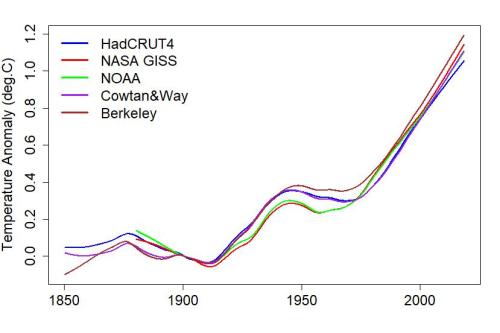
Then points out that if you use Cowtan & Way you have a third less burnable carbon in your carbon budget than if you use HadCRUT4, which omits the Arctic (the fastest-warming region on earth).
In an earlier post he uses a trend line from 1970, and finds that the different data sets again vary, but roughly the answer is 2040, which is what the IPCC says.
However, David Spratt cites research by Benjamin Henley
and Andrew King showing that the 1.5°C target could be reached by between 2026 and 2031 depending on the phases of the Interdecadal Pacific Oscillation (IPO).
The difference here is that the IPCC follows the pack, whereas Spratt cites quality recent research. There is a risk that the new research is right. However, policy makers will blithely ignore it until it is incorporated perhaps in the next IPCC report years down the track.
Is there a carbon budget remaining for 1.5°C?
I addressed this issue in June 2014 in the post The game is up where I cited David Spratt and found evidence to support him. Spratt said:
We have to come to terms with two key facts: practically speaking, there is no longer a “carbon budget” for burning fossil fuels while still achieving a two-degree Celsius (2°C) future; and the 2°C cap is now known to be dangerously too high.
In Spratt’s commentary on the IPCC report before publication IPCC’s political fix on 1.5°C will undermine its credibility, he writes:
-
“We have no carbon budget left for the 1.5°C target and the opportunity for holding to 2°C is rapidly fading unless the world starts cutting emissions hard right now,” says Prof Michael Mann. Prof. Stefan Rahmstorf of Germany’s Potsdam University considers that we are now “in a kind of climate emergency” and that at least 1.5°C is “locked in”. (“Locked in” means that the warming will occur for the present level of emissions in the absence of large-scale carbon drawdown and/or solar radiation management.) Three other senior Australian scientists to whom I have spoken agree with the 1.5°C figure articulated by Mann and Rahmstorf. Some think it is likely to be somewhat higher.
Carbon Brief looks at why the IPCC expanded the carbon budget to 10 years of emissions at current rates from the three years of IPCC5.
You can choose your experts. I would have a lot of faith in Rahmstorf and Mann.
Sea level rise
If we look at my old favourite of sea level rise, the IPCC press release says that:
- by 2100, global sea level rise would be 10 cm lower with global warming of 1.5°C compared with 2°C.
From the Summary for Policymakers, Section B, p.10:
- Model-based projections of global mean sea level rise (relative to 1986-2005) suggest an indicative range of 0.26 to 0.77 m by 2100 for 1.5°C global warming, 0.1 m (0.04-0.16 m) less than for a global warming of 2°C (medium confidence).
Then we have a warning:
-
Sea level rise will continue beyond 2100 even if global warming is limited to 1.5°C in the 21st century (high confidence). Marine ice sheet instability in Antarctica and/or irreversible loss of the Greenland ice sheet could result in multi-metre rise in sea level over hundreds to thousands of years. These instabilities could be triggered around 1.5°C to 2°C of global warming (medium confidence).
They gesture to ice sheet decay, but then put then give us scenarios that put us in harm’s way, an outcome, I think caused because of the political nature of the context in which the paper was written.
Last July in a post Can we get to 350ppm? I showed this graph of CO2 at NASA:
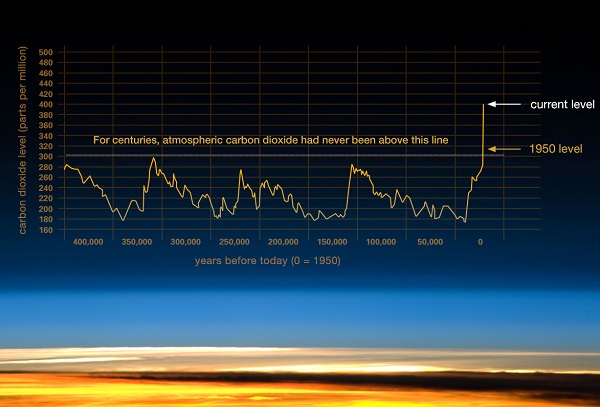
The last interglacial, the Eemian, was reached about 120,000 years ago with CO2 emissions of only 300 ppm. Back then the sea was 6-9 metres higher than now. We have already left the Eemian behind us and are in territory back in the mid-Pliocene, about 3 million years ago, and seem to be heading for the mid Miocene, about 15 million years ago.
See also this graph from a paper by James Hansen and some other scientists with established reputations – Young people’s burden: requirement of negative CO2 emission:
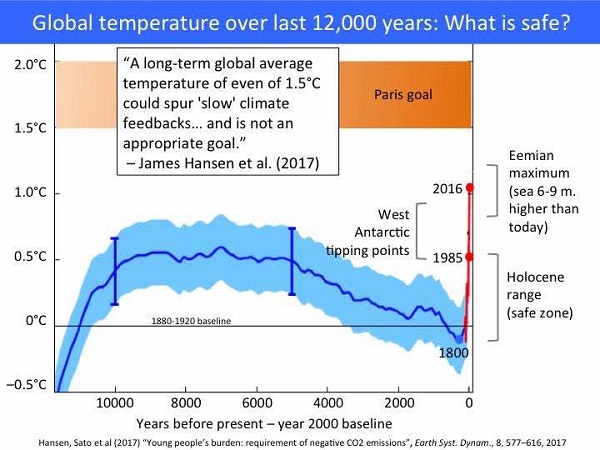
David Spratt in this article says:
- By 1.5°C, a sea-level rise of many metres, and perhaps tens of metres will have been locked into the system. In past climates, carbon dioxide levels of around 400 ppm (which we exceed three years ago) have been associated with sea levels around 25 metres above the present. And six years ago, Prof. Kenneth G. Miller notes that “the natural state of the Earth with present carbon dioxide levels is one with sea levels about 20 meters higher than at present”.
In Scoping sea long-term level rise I posted David Archer’s 2006 graph:
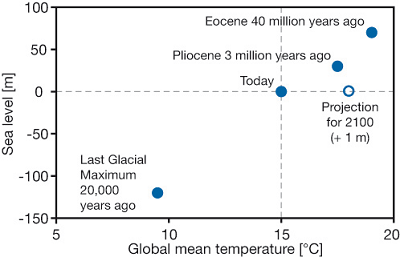
From this graph we can readily see that when 10-12°C gives you close to 200 metres of sea level change each degree means a lot. Remember Gavin Schmidt said 1.5°C amounts to a third of an ice age unit, the amount of warming from the depths of the last ice age 20,000 years ago to the mid-19th Century.
Can the climate be stabilised at 1.5°C?
This hinges on the phenomenon of ‘tipping points’. Graham Readfearn has recently posted a piece Earth’s climate monsters could be unleashed as temperatures rise.
Then there was the “Hothouse Earth” paper, which received widespread publicity recently – Trajectories of the Earth System in the Anthropocene.
I plan to do a post on this shortly, but the loss of Arctic sea ice, the potential instability of the Greenland and West Antarctic ice sheets, plus methane from permafrost and ocean clathrates comprise neglected factors within the IPCC scenarios.
In this discussion from the Climate Matters series Scientific Reticence: A Threat to Humanity and Nature with James Hansen, Pam Pearson and Philip Duffy, Pearson says that according to the best information, which last November is likely more recent than the IPCC process, the threshold for the irreversible melting of the Greenland ice sheet is a warming of 1.6°C. That’s 6-7 metres of SLR. However, if Greenland goes, so does West Antarctica (5-6 metres), land-based ice (1 metre) and a slice of East Antarctica.
Hansen says if you want to arrest ice sheet decay once it has started in earnest, you will need temperatures lower than pre-industrial.
Phillip Duffy, CEO at Woods Hole, said that land GHGs stored in northern permafrost lands amounts to three times what has been put into the atmosphere during the industrial era. He said that it is starting to go, but is not included at all in climate models. This alone, leaving aside other tipping points, casts serious doubt on whether it is possible to stabilise the temperature at 1.5°C.
Here’s David Spratt again:
Coauthor of the recent “hothouse” paper, Hans Joachim Schellnhuber, director of the Potsdam Institute for Climate Impact Research, says: “What we do not know yet is whether the climate system can be safely ‘parked’ near 2°C above pre-industrial levels, as the Paris Agreement envisages. Or if it will, once pushed so far, slip down the slope towards a hothouse planet. Research must assess this risk as soon as possible.”
The end of coal
Graham Readfearn has looked at the end of the fossil fuel era in IPCC Report Says 1.5C Climate Target Is Reachable, But Only With Rapid Fossil Fuel Phase Out:
- Four scenarios are modeled in the report that reflect different strategies governments could take to deliver “no or low overshoot” of the 1.5°C target.
Within these scenarios, by 2030 coal use would need to drop between 25 percent and 60 percent compared to 2010. By 2050, coal use drops between 73 and 97 percent.
Dr. Joeri Rogelj, of the International Institute for Applied Systems Analysis in Austria and a coordinator of the IPCC report chapter looking at pathways to cut emissions, told DeSmog: “The report provides quite clear messages for fossil fuels in a 1.5°C world, but also highlights that the future out to 2050 looks differently for the various types of fossil fuels.
“For coal the picture is the clearest. It is reduced 75 to 95 percent from 2010 levels across the entire economy and fully phased out from producing electricity.”
He said by 2050, renewables would need to generate between 70 and 85 percent of global electricity to meet a 1.5°C target.
“Oil use is reduced consistently across most of 1.5°C scenarios, about a 30 to 80 percent reduction from 2010 levels in 2050. Depending on how gas is used and how successful carbon capture and storage (CCS) is, natural gas use is reduced by more than 50 percent or stays roughly similar to 2010 levels.”
Climate change moves to the centre of politics
With all its limitations the IPPC report is a giant wake-up call. The LNP Coalition has been forced into overt inanities. Labor has taken the high ground, but their aim of 45% reductions in emissions is also manifestly inadequate.
The Greens may be in a position to exercise leverage after the next election. We’ll have to see how that works out.
Last election climate change was avoided by Labor because they knew it would produce a Turnbull rant, the mother of all scare campaigns, about blackouts caused by ideological frolics by South Australia with renewable energy causing blackouts, rather than a dirty big storm.
Last Monday Ben Potter wrote an article in the AFR Labor, Coalition square off in Great Barrier Reef election:
- Australia faces a climate change election on the fate of the Great Barrier Reef after a landmark report warned that coral reefs would be destroyed by global warming of 2 degrees Celsius.
Labor’s acting energy spokeswoman Penny Wong laid down the gauntlet on Monday, doubling down on Labor’s 45 per cent emissions reduction target and accusing the Morrison government of having “absolved themselves from any responsibility in tackling climate change”.
Of gas Potter says:
- Renewable energy would supply 70-85 per cent of electricity, and gas – another strong export industry for Australia – would supply 8 per cent of electricity when coupled with carbon capture and storage (CCS). CCS has been demonstrated technically but its cost is prohibitive and no commercial rollouts on existing thermal power stations have resulted from trials conducted in the US, Canada, Australia and China.
This opens the opportunity for discussion of other forms of firming wind and solar, such as pumped hydro. However, the discourse is moving away from gas as being the answer.
This graph shows the impacts of 1.5°C and 2°C in the Australian context:
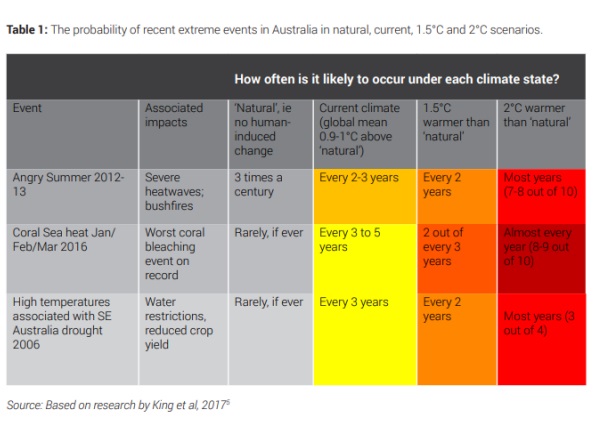
This one highlights the policy choices:
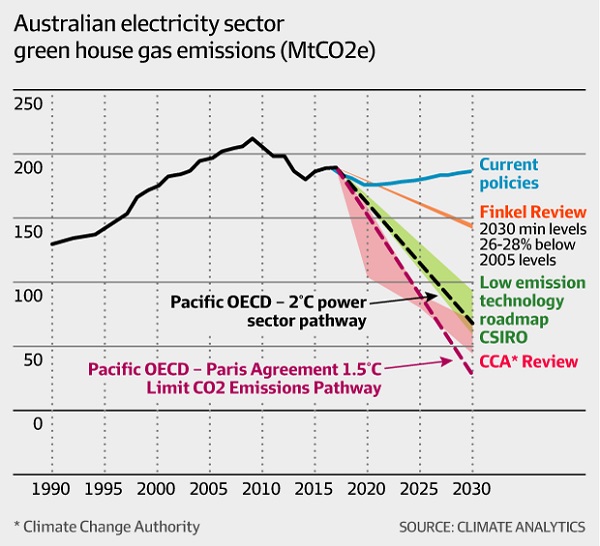
Remember, the following graph represents our Department of Environment’s representation of current government policy:

Now we have the BCA (Business Council of Australia) saying that if government can’t do energy policy, business will go it alone:
And:
Finally, the Energy Security Board, those “experts” who came up with the NEG (National Energy Guarantee) appear to be joining the rebellion.
The Coalsheviks are becoming isolated. Surely Scott Morrison will realise that is not a good place to be politically, unless the lights are on but no-one is home in the top room.
Update: The Guardian has come up with the following graphic in a number of articles, including this one, showing increasing risk in relation to warming:
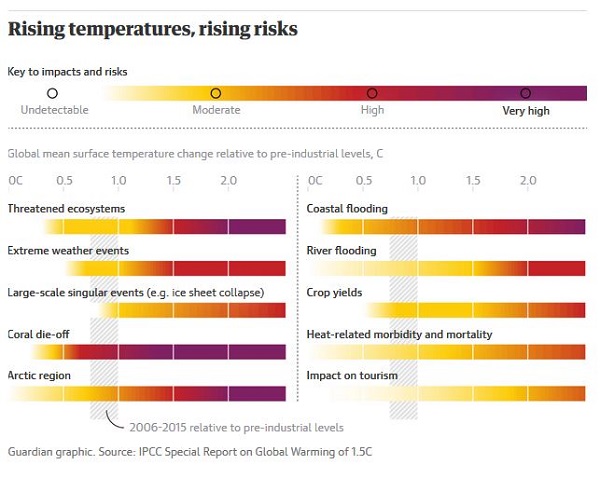
It’s derived from the IPCC report, although not presented in exactly the same way. Anyone looking at that would conclude that we are entering a new phase of climate now which leaves behind the Goldilocks era of the Holocene.
The IPCC takes the average of the 1850 –1900 period as the baseline, then takes current warming as the observed global mean
surface temperature (GMST) for the decade 2006 – 2015. On this basis current warming is 0.87°C.
Hansen et al in Global Temperature in 2017 use the 1880 – 1920 period as a starting point, mainly because comprehensive global measurements are not available before 1880.
They use a linear trend line from 1970, when temperatures seriously started heading north. This gives them warming of +1.07°C at the end of 2017. The year 2017 itself was +1.17°C, the second highest ever with NASA GISS, with the last three years above the trendline. The 2017 result caused concern, because it followed two strong El Niño years and would normally be expected to fall below trend. So the trend may be quickening, time will tell.
Here’s the Hansen graph:
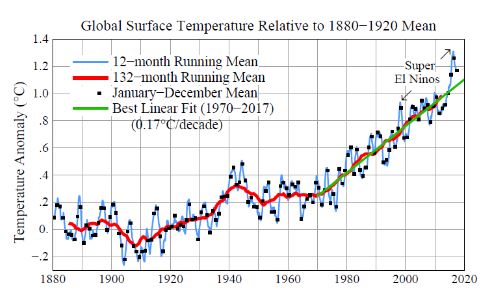

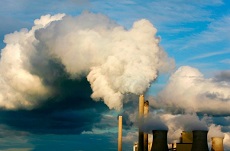
I had to change the structure four times and become quite obsessive in the end to get this out.
Too early for me to judge how well it came out, but somewhere close to what I intended.
If it’s like your past work including every post this year, BB, it’ll be a little bobby-dazzler.
Thanks,
Ambi
Branson was calling for WWIII on climate change the other day. The Paris agreement is only p…sing in the wind.
We also need a very strong campaign to reduce world population.
Ambi, it wasn’t little, that was a large part of the problem. Ended up 3174 words, when I could have written 7,000.
John, I have to agree, Paris was p***sing in the wind. A political fix.
Population is out of control in Africa and a large part of the world from Iran to Indonesia.
I’ve done an update.
Update: The Guardian has come up with the following graphic in a number of articles, including this one, showing increasing risk in relation to warming:
It’s derived from the IPCC report, although not presented in exactly the same way. Anyone looking at that would conclude that we are entering a new phase of climate now which leaves behind the Goldilocks era of the Holocene.
The IPCC takes the average of the 1850 –1900 period as the baseline, then takes current warming as the observed global mean
surface temperature (GMST) for the decade 2006 – 2015. On this basis current warming is 0.87°C.
Hansen et al in Global Temperature in 2017 use the 1880 – 1920 period as a starting point, mainly because comprehensive global measurements are not available before 1880.
They use a linear trend line from 1970, when temperatures seriously started heading north. This gives them warming of +1.07°C at the end of 2017. The year 2017 itself was +1.17°C, the second highest ever with NASA GISS, with the last three years above the trendline. The 2017 result caused concern, because it followed two strong El Niño years and would normally be expected to fall below trend. So the trend may be quickening, time will tell.
Here’s the Hansen graph:
John D has just brought to my notice much material at The Conversation and this startling one from the Parliamentary Library:
Climate target set by IPCC requires 12 Australian coal-fired power stations to close: Parliamentary Library report
At The Conversation, they aren’t completely consistent in assigning tags, but try IPCC Special Report and Intergovernmental Panel on Climate Change.
Of special note – Mark Howden and Rebecca Colvin
New UN report outlines ‘urgent, transformational’ change needed to hold global warming to 1.5°C. Howden was involved in writing the IPCC report at a senior level.
Also Alan Finkel – The science is clear: we have to start creating our low-carbon future today.
The Guardian is also writing up a storm.
Carbon Brief have reaction from individual scientists.
See also Climate Central:
Limiting Global Warming to 1.5°C Will Require Deep Emissions Cuts.
Hi All ‘Been a while, and I confess to having not been watching here.
‘Been a while, and I confess to having not been watching here.
I have to raise one of my chestnuts here – Adani’s Carmichael mine. By some accounts, it is going to proceed forthwith. They claim funding is in place as are approvals. Some new scheme links their proposed rail line to existing rail (albeit different gauge).
I have heard nothing from government so I begin to think that tacit approval is in place, supporting the project.
So in spite of the evidence as outlined above, our governments are throwing us under the bus. You have to ask what is their reward for taking globally treasonous actions.
Geoff H, we’ve missed you. Welcome back!
Yes, I have an uneasy feeling about Carmichael.
This is Laura Tingle on IPCC:
My impression is that ScoMo is a decent enough bloke, but he’s not a thinker and doesn’t have a well-formed thought in his head about climate change.
Thank’s Brian… somehow I fell off the subscription list and I’ve has other things to bother me. I expect to complete my Masters at the end of October, then I don’t know what to do with myself but recreational research sounds like a nice change.
Geoff, yes, I guess we all have habits, and when something changes we ride with it.
I have to apologise about the disrepair of the email subscription list, because if you fall off you can’t get back on. We are on Viv’s list of things to do, but she’s got a full life.
It’s largely a foreign world to me, but I get strange messages about who is following us on Twitter, which seems to work.
Geoff Henderson (Re: OCTOBER 14, 2018 AT 2:41 PM)
“By some accounts“? Who is saying it, Geoff H? Do you have links? I suspect talk is cheap to maintain a positive “vibe” with investors.
Posted at The Guardian is an article by John Quiggin headlined Adani’s rail line cut shows project is on life support but still a threat to climate, dated Sep 16 (a month ago). The article begins with:
Bold text my emphasis.
New solar-PV and wind are decisively cheaper than new coal – you cannot ignore the economic reality. Adani Carmichael mine will be a “stranded asset”. The question is whether investors will throw away more money on this project, or pull the plug and kill it for good.
GM: Adani as a whole benefits by having the Adani mine on its books as an asset. It also has the potential to claim compensation if an Australian government shuts it down completely.
So don’t expect the Adani project to disappear in the near future.
GM I know you like compelling evidence and that’s fair enough. In this case, I am relying upon news articles that are low on the academic hierarchy and may well have been based on a press announcement by Adani.
Historically there are good reasons to doubt anything from Adani, or about Adani, and JD’s point is strong. Adani needs Carmichael on its books to keep its bankers settled. And if we nix the project then we may be up for significant compensation.
But the longer it dribbles on, the less value the mine has, so we will see.
Does anyone know the outcome of the Aboriginal claims on the land?
Hope your Masters is going well, Geoff.
Cheers
A
John Davidson (Re: OCTOBER 15, 2018 AT 12:52 PM)
The day of reckoning must come eventually. On paper, Adani Carmichael may still be an asset to appease the bankers/investors. But sooner or later, a decision needs to be made to commit more money to develop the site/infrastructure, or kill it. The longer the delay, the more likely the present gradual coal market decline turns into a collapse.
I suspect the governments (state & federal) are aware of this potential liability and are ensuring that this is avoided.
Geoff Henderson (Re: OCTOBER 15, 2018 AT 1:09 PM)
Agreed. Time is running out.
There’s a re-post today on Climate Code Red by Scott Waldman headlined New IPCC climate report actually understates threat, researchers say. The article includes:
Andrea Dutton, a sea-level-rise expert at the University of Florida in Gainesville, says:
Thanks Ambi. Supposed to submit end of month but met my supervisor today and we need to massage the research question. That’s okay but a lot of re-writing…
Interesting topic, all about alcohol management plans in Queensland . They were a response to the Fitzgerald Report and have been developed and managed under a Justice system but it is clear that it should be under Health. Oh well Judy Spence had to be seen to respond to Fitzgerald 16 years ago but it’s time for a review.
Geoff M thanks for the heads up to Scott Waldman on the IPCC report at Climate Code Red.
I would emphasise this:
Back in 2008 economist Martin Weitzman was writing about fat tails and low-probability extreme events. See Peter Wood, and my post Quiggin on climate risk. It includes this figure which is actually from IPCC AR4 published in 2007:
Please note that the graphs do not include slow feedbacks.
Geoff M, Matthew Stevens had an article Coronado IPO to crown coal’s comeback. In it he says three of the four big banks have shunned Adani, doesn’t say which hasn’t.
however, the main point of the article is that fund managers are being carted up north of Blackwater:
Stevens is saying that announcements of the death of coal have been greatly exaggerated.
Elsewhere Stevens has said he’s fond of coal, but he’s reporting real events. As you no doubt know, IPO stands for Initial Public Offering, or a stock market launch to raise investment funds.
Today also the Courier Mail had an article Jobs, investment surge as coal refuses to die:
Not good news for the planet.
Not sure about a group called “Market Forces”, I would look closely before taking them as gospel. But they have a nicely presented piece here: https://www.marketforces.org.au/info/key-issues/theadanilist/ That offers some insights into who’s doing what with Adani.
Interesting that Adani is being sued by two contractors for around $17 million – reported in September 2018 here: https://www.marketforces.org.au/adani-accused-of-not-paying-contractors/
Brian (Re: OCTOBER 15, 2018 AT 11:01 PM)
Thanks for the link to “Coronado IPO to crown coal’s comeback“. Yesterday, the SMH also posted an article on Coronado by Cole Latimer headlined Asian, UK investors may beat Aussie backers for major coal listing. The article begins with (bold text my emphasis):
I think the Coronado IPO is primarily about investing in metallurgical coal (aka coking coal for steel-making), not thermal coal (but do correct me if I’m wrong). I think the new arrangements with Stanwell power station is just a side deal to offload sub-par (i.e. below spec) coking coal as thermal coal.
From Wikipedia:
I suspect Coronado is perhaps looking to extend/develop Curragh Coal Mine’s reserves further, thus the need for an IPO. The AFR article you link to says:
Coronado also has operations in the US states of Virginia and West Virginia.
The Morning Bulletin has an article headlined Australia’s coking coal statistics make for good reading, dated April 6. It includes some stats on met coal. I note that global met coal export demand is now above 300Mt/y (per the figure: Global long term metallurgical coal export demand forecast). I can’t easily find a figure for total global met coal production.
Putting that in perspective, global total coal production (i.e. all coal grades – anthracite, bituminous, sub-bituminous and lignite) in 2013 reached a peak of about 8.1 billion tonnes.
CoalSwarm/Greenpeace Report Shows Pathway to 1.5°C, posted Oct 7.
CoalSwarm and Greenpeace have analyzed the IPCC findings to see how a two-thirds reduction in coal power generation in 2030 and a near-total reduction by 2050 can be achieved. Their report, is titled A Coal Phase-Out Pathway for 1.5°C.
RenewEconomy has a podcast interview with Ted Nace, the author of Gangs of America (about the rise of corporate power), and the NGO he founded and directs, CoalSwarm.
Thanks for putting those articles in context, Geoff M.
Still we are going to have to make steel without coal, or bury the CO2 emanating from that activity.
I notice that the CoalSwarm/Greenpeace Report Shows Pathway to 1.5°C has the OECD getting out of coal by 2030.
Brian (Re: OCTOBER 16, 2018 AT 11:28 PM)
Yep – on 2 counts:
1. Humanity needs to stop putting more CO2 into the atmosphere to avoid dangerous climate change; and
2. Metallurgical (or coking) coal is a finite resource – it will inevitably be depleted if we continue to consume it.
These may be of interest: ABC Science Show segments:
How to remove greenhouse gases from the atmosphere, broadcast Oct 6:
Carbon capture and storage places costs and risks with all future generations, broadcast Jun 2:
Brian, you say:
At ABC.net.au, posted Oct 13, is an article headlined Climate target set by IPCC requires 12 Australian coal-fired power stations to close: Parliamentary Library report.
A radical path is required to dramatically reduce our emissions.
Geoff M you might get some hope from Giles Parkinson yesterday https://reneweconomy.com.au/can-pumped-hydro-grab-centre-stage-from-battery-storage-77272/?utm_source=RE+Daily+Newsletter&utm_campaign=6ff40ed5d7-EMAIL_CAMPAIGN_2018_10_15_10_49&utm_medium=email&utm_term=0_46a1943223-6ff40ed5d7-40335033
A bit rambling but he does give pumped hydro a look. There is extensive commentary at the end of the article.
I have raised pumped hydro before and I still think it is the best option for many reasons. I don’t have much more than a cynical view of Snowy 2. That seems possible only with divine intervention or an entirely new breed of politicians concerned with the future of Mankind. But pumped hydro, established at many sites is much more viable and way more resilient than a single facility such as Snowy 2.
The Curragh washery was designed to produce metallurgical coal with thermal coal as a lower grade byproduct with poor coking properties. The flowsheet is changed depending on what seam/location the feed came from. (The coarser material in some feeds has poor coking properties.)
Curragh bought their leases from Stansthorpe power station. Part of the agreement included supplying the power station with coal at a very low price. Curragh would have loved to sell all of their thermal coal to the broader market because of the much higher price.
Most metallurgical coal is used in the production of steel based on blast furnaces. However, many blast furnaces reduce their need for high priced metallurgical coal by injecting non-met coal (PCI) into the furnace.
Some steel is made using natural gas to convert iron ore to steel. There is no technical reason why steel could not be produced using renewable hydrogen.
Geoff Henderson (Re: OCTOBER 17, 2018 AT 12:37 PM)
Thanks for the link to the RenewEconomy article – I did see it yesterday.
Solar-PV costs are in the ballpark AU$40/MWh, but capacity factors not much better than 30%, unless tracking is included at extra cost. And it’s intermittent, requiring storage – hence either battery or pumped-hydro needed to augment ‘dispatchability’.
Wind costs are ballpark AU$55/MWh, with capacity factors at some sites up around 50%. It’s intermittent too, also requiring storage.
Pumped-hydro (and batteries) are energy consumers – more energy is consumed, than is returned in generator mode. They do have their place.
Professor Blakers says battery storage + pumped-hydro + HV interconnectors + some spillage of PV & wind will cost an additional AU$25/MWh on top of the cost of PV & wind at 100% renewable energy electricity generation utilization. (See Prof Blakers sworn testimony transcript, p53, at the public hearing on Feb 21 conducted by the NSW Parliament Select Committee on Electricity Supply, Demand and Prices in NSW).
SolarReserve’s Submission (#246) to the NSW Parliament Select Committee on Electricity Supply, Demand and Prices in NSW includes this:
CSP currently costs AU$78/MWh for South Australia’s proposed single unit 150 MW capacity with 8 hours thermal storage at max power output. I stress this is a one-off generator.
The question I ask is: What if we have multiple concurrent-built (perhaps up to 5 units) CSP generators with large generating capacity (i.e. 200 – 220 MW) with more storage (i.e. 16 – 17 hours) enabling larger capacity factors (i.e. up to 70%)? Would that bring down the costs below the AU$70/MWh threshold or closer to AU$60/MWh? If it can then I think it may just become the dominant electricity generator technology. It doesn’t exclude PV, wind, batteries and PHES – they all have their place, but CSP satisfies many key factors (i.e. dispatchability, operational longevity, recyclable at end-of-life, rapid construction/deployment time, and affordability in the one package).
Geoff M some strong points.
I have a preference for infrastructure that lasts a long time rather than a shorter time so I think pumped hydro might have an advantage long term.
I think that price/costs get a bit too much attention at the detail end. I see the need for renewables as planet-saving, or mankind-saving whatever you want to call it. If that is the case it is functionality and science should guide the decision makers, more so than accountants or economists. It’s become a question of “can we afford not to do this”.
Geoff Henderson (Re: OCTOBER 17, 2018 AT 1:43 PM)
It still needs to be affordable – someone has to pay for it.
The IPCC Special Report Global Warming of 1.5°C, leaves us in no doubt what needs to be done. The question now is whether humanity has the will to do what needs to be done.
I lodged 8 questions on the ABC Q&A website on Monday (Oct 15) from 12:22:36pm. Yesterday, they were published here (note: eventually they will scroll-off the bottom of the page as new questions are added at the top).
My suggestion that Q&A have a special event that explores and compares the technologies available, I think, would give people perhaps a better understanding of what’s possible and then judge whether the political party policies are adequate for the task of rapid reduction in emissions. Interesting to see if the idea takes hold, and whether all the suggested participants engage, or decline attending.
John D
Renewable hydrogen, H2, looks to have so many advantages.
I recall in the 70s, early 80s, several research engineers advocating a “hydrogen economy” [for transport, manufacturing etc.] to displace oil/coal.
Perhaps it just takes a few decades and a real emergency to get these things off the ground?
GM: Thanks for all that price information. However, it is a shame the power costs you quote are all in $/MWh given that cents per kWh are what most of us familiar with. ($100/MWh=10 cents/kWh, which means that the differences you quote above are relatively small.
GH: Energy storage is rated by the energy stored and the rate at which it can be stored and recovered. Pumped storage tends to be high storage, low store/recovery rate but it a requires a site that has reliable water supply and low cost upper and lower dam storage. Batteries are more about being able to provide a fast response over a relatively short period of time.
Solar towers are somewhere in the middle but have the attraction of being able to be set up with back-up molten salt heating. Highly desirable if there is a long failure somewhere in the system.
GM – It still needs to be affordable – someone has to pay for it.
I think that given the stakes, normal commercial considerations might have to give ground.
If your life depended upon paying someone to throw you a rope, would you pay the same price as say, Bunnings would sell that rope for? I think you would pay a premium quite willingly.
JD – about hydrogen – can’t be produced using nuclear power at the atomic level or is it still an electrolytic process?
GM: There are lots of ways of producing hydrogen in addition to reforming natural gas and electrolysis. Possibilities include artificial photosynthesis. Google to your heart’s content.
GM: You can also produce hydrogen by breaking down ammonia. It is part of proposals that involve producing renewable ammonia, transporting the ammonia as liquid ammonia and then separating the hydrogen out to use as fuel cell feed.
John Davidson (Re: OCTOBER 17, 2018 AT 5:12 PM)
But you have shown how easy the conversion is. The prices I quoted above are wholesale electricity generation costs. You need to add-in transmission and retail costs on top of these. Generator costs are a small part of the electricity bill you and me pay.
Geoff Henderson (Re: OCTOBER 17, 2018 AT 5:18 PM)
In some respects, I agree with you. Historical examples include allied (and axis) mobilization of industry during World War 2, and the Marshall Plan for the recovery of Europe after WW2. An emergency response is required to rapidly transition our civilization to affordable, reliable, long-term sustainable, zero-carbon emissions energy supply solutions.
But you cannot ignore the limitations of physics, chemistry and biology, and the engineering principles that are based on these limitations. Energy to sustain our civilization long-term needs to be affordable on an EROI basis. Please read Section 5: Energy Return on Investment in the paper Twenty-First Century Snake Oil. The key points (bold text my emphasis):
Nothing happens without energy.
You can have all the money in the world, but if you don’t have access to energy systems that are above the required EROI threshold, then you cannot sustain our civilization at a particular standard of living.
Unaffordable energy (i.e. poor EROI below the required threshold) means life becomes unaffordable.
Low EROI means higher costs; high EROI means lower costs.
Hmmm GM, looks like we are screwed then doesn’t it?
Underlying the discussion are some assumptions such as a population of ~8.5 billion people, a refusal to accept really significant lifestyle changes, refusal to cause a radical redistribution of wealth and an unlivable climate.
I don’t disrespect the EROI position, but I do think when the crunch really starts, the EROI will look a bit quaint.
Too unreal? Not really. This article: https://www.vox.com/policy-and-politics/2018/10/16/17951596/kavanaugh-trump-senate-impeachment-avenatti-democrats-2020-supreme-court was cited by David Leonhardt in The NY Times today. I see the same pattern emerging in Australian politics. This is very scary to me, it should concern all Australians. Squeezed now between China and the US, the oil market in the hands of the Saudi’s (who can bear massive influence on price) and government that can’t find its butt with two hands and a flashlight, EROI isn’t high on my List.
Geoff Henderson (Re: OCTOBER 18, 2018 AT 10:52 AM)
If we carry on BAU (i.e. continuing to rely heavily on fossil fuels) then we are screwed.
But I think there’s still some hope, so long as we begin a rapid transition away from fossil fuels BEFORE global ‘peak oil’ and ‘peak gas’ supply. If we don’t do this then I think we will be screwed.
The transition of electricity generation to renewables is the easier task (but by no means is it easy) – the solutions are there, but the will to transition is still not there. But without reliable, affordable electricity then we don’t have an energy supply foundation to sustain our civilization. The more difficult task is finding and deploying alternatives to petroleum-based fuels – all the more difficult if there’s no long-term sustainable, electricity supply (not dependent on fossil fuels).
I agree on renewable fuels and I am hoping that battery technology will develop to enable most vehicular transport to be electric. Graphene batteries are looking very hopeful and if they scale up to cars then many of the arguments against EV’s (endurance, charge time, short battery life etc.) disappear. Samsung is already touting Graphene batteries and hopefully, that is a good sign. Probably worth spending time checking it out but I’m in time-trouble here…
GH: At the moment the practicalities of a battery powered transport system look a bit daunting, particularly if we insist on simply electrifying the family tank car. We could achieve a lot by reducing the size of electrified vehicles to better match normal means instead of driving vehicles that are designed to meet occasional means.
Keep in mind that batteries are just one of a number of potential renewable transport energy sources . My current thinking is that battery power makes sense for vehicles whose daily travel is normally quite limited while fuels like renewable liquid ammonia with fuel cells would be used for vehicles that have to travel longer distances. Liquid ammonia could be used as the only fuel or alternatively used to generate electricity in hybrid vehicles where the generator cuts in when battery charge drops below some limit.
Thanks, JD, I confess to zero knowledge of the Ammonia/hydrogen potential, but if it is safe and it works that might be a great outcome. If you could recharge a car simply by adding some ammonia that would be good.
Either way, I think there are ways and means of getting rid of coal and a large chunk of oil-based fuels. Need some serious political will.
GH: A tesla 3 will take 14 mins to charge enough for 100 km worth of travel using their fastest charging system. That is an enormous amount of charging infrastructure and enormous charging times compared with filling a tank with petrol.
I believe liquid ammonia could be handled using LPG infrastructure. Other renewable transport fuels such as renewable methanol could use existing petrol infrastructure.
For me the attraction of liquid ammonia is that it can be produced without having to extract CO2 from the air.
Re-charging time?
14 minutes sounds OK if it can be done in the car park at work, or in the car park at the local shops while I’m walking around the shops; or at home.
Hang on, I thought extracting co2 from the air was a good thing.
Geoff H
The article you linked to at 10.52am seems to be based on the false assumption that the Presidential candidate with the highest popular vote must be elected.
That “rule” doesn’t apply in Australian House of Reps elections, either.
Every voting system can toss up odd results. Democratic nations need the civic resilience to endure these events.
Fear and loathing? Wrong way: go back.
John Davidson (Re: OCTOBER 18, 2018 AT 2:08 PM)
Frequent fast charging and deep discharging reduces battery operational life considerably. See Professor Maschmeyer’s sworn testimony, from page 14, that includes (on page 16, bold text my emphasis):
Filling a tank of petrol requires an enormous amount of infrastructure – oil rigs, pipelines, tankers, refineries, more tankers, a network of filling stations, etc. Perhaps you meant that the petroleum fuel infrastructure is existing, whereas the battery charging infrastructure network is still very small-scale by comparison? Unfortunately, we cannot continue to burn hydrocarbons, so unless the petroleum fuel infrastructure can be transformed to handle alternative zero-carbon emissions liquid fuels, then it will likely become redundant.
You also say:
Methanol is more corrosive than petrol and diesel fuels because it’s hydroscopic (i.e. attracts water/moisture) and is more aggressive on plastic tubing and fittings, although I don’t think this is an insurmountable problem. Methanol has lower energy density at 15.6 MJ/L, whereas ethanol’s is 24 and petrol/gasoline’s is 33 MJ/L. I think the key question for the sustainability/viability of so called “renewable” methanol concerns its EROI. Methanol manufacture must be independent of fossil fuels and needs to exceed the EROI threshold necessary for a required standard of living, otherwise it won’t be sustainable.
You also say:
Liquid ammonia in concentrated form is a very aggressive, highly toxic substance. Wikipedia on Ammonia includes:
Adequate containment is key to minimize risk of injury/death, but I have doubts whether the risk could be adequately minimized in a domestic situation.
I suspect compressed hydrogen contained in a graphene matrix would be a safer transport fuel, compared to concentrated liquid ammonia, but the technology appears to be still developing and is not currently deploy-able. Interesting to see how this tech evolves.
A new report to the Club of Rome from Stockholm Resilience Centre and BI Norwegian Business School, authored by Jorgen Randers, Johan Rockström, Per Espen Stoknes, Ulrich Golüke, David Collste and Sarah Cornell, titled Transformation
is feasible: How to achieve the Sustainable Development Goals within Planetary Boundaries, was introduced at the Club of Rome’s 50 years anniversary conference on Oct 17.
The NSW Independent Planning Commission (that has superseded the NSW Planning Assessment Commission) has been tasked to make a final determination for the Bylong Coal Project. The Bylong Coal Project is a “greenfield” open cut and underground coal mine project.
I note that IEEFA has been engaged by EDO NSW on behalf of the Bylong Valley Protection Alliance to prepare an expert report, dated June 2018. The Executive Summary begins with:
I think these statements apply equally to any new “greenfield” coal mine projects.
The IPCC Special Report titled “Global Warming of 1.5°C“, published Oct 8, reinforces the futility of approving any new coal mine developments.
The problem is, Geof M, is that as I understand it, the NSW Government owns most of the coal reserves in the state, and that presents a complicated conflict of interests.
…….a complicated conflict of interest that harks back to the time of the creation of Torrens Title in Australia. There is an interesting research subject for someone.
BilB (Re: OCTOBER 20, 2018 AT 10:07 AM)
Yep. And it’s not just NSW – it’s also Queensland, Victoria, WA and federally. The evidence is stacking up and compelling, but the governments won’t pull their proverbial heads out of the ground. New developments will be “stranded assets” that will need tax-payers to fund the environmental clean-up.
It’s up to the voters to tell them who is in charge. But the voters need to be well-informed, or else they can be hoodwinked into voting contrary to the nation’s best interests.
BilB – it shows the importance of EROI as only one of the dark forces opposed to saving the futures of our children
Yes Geof H. As I discovered from attending several Liberal Party functions to discuss and promote the concept of Capital Growth Restrained Property Titles to create a permanent pool of affordable accommodation, government MP’s who by percentage are the highest users of negative geared multi property ownership, a structure that requires non property owning people to rent and pay for those properties, have a vested interest in ensuring a significant pool of “desperate” people to provide rental pressure to make their investment viable.
It is simple maths, if one in ten people in an economy own 10 properties each, then there will be only one kind of property owner, or there will be a lot of vacant properties. A lot of vacant properties owned by rich people is never going to happen while they have political influence.
Coal on the other hand has a raft of other considerations. The most important of which is that coal can be put to far more valuable use than just burning it for its intrinsic energy potential. Unfortunately our politicians (Lawyers and the like) are ill equipped to understand this and act on it. Condensed Carbon is the greatest asset for the future of civilisation and human development. Squandering it in the manner that we are now is a tragedy of immense future proportions.
Bilb:
We need to get to the point where all fossil carbon stays in the ground. Can’t think of any application off-hand where fossil carbon cannot be replaced using existing tech.
Posted Monday (Oct 22) at ClimateCodeRed.org is an article by David Spratt headlined World acknowledges unprecedented climate challenge, so what should a Labor federal government do?
Check it out…
Thanks for that GeoffM.
On US unconventional oil…
Posted on IEEFA’s website on Oct 17 is an article headlined IEEFA U.S.: More red flags on fracking-focused companies. It refers to an IEEFA research brief published jointly by IEEFA and Sightline Institute that describes how fracking companies continue to struggle.
Key findings:
IEEFA warns:
Geoff, do you think that some of those “struggling” companies are receiving subsidies? And if they are, a public return to profitability might signal the end of those subsidies, so you hide those profits in various ways. It would not be a big surprise.
Posted earlier this week at RenewEconomy is an article by Giles Parkinson headlined Snowy says cost of “firm” wind and solar significantly below current base-load prices.
Snowy Hydro CEO, Paul Broad, told a Senate Estimates Committee hearing on Monday:
The article also says:
Now where have I seen similar figures before? Ah, yes here. Professor Blakers’ sworn testimony (p53) includes:
When are governments going accept expert advice?
Geoff Henderson (Re: OCTOBER 25, 2018 AT 11:01 AM)
From the IEEFA report:
There’s no mention of subsidies that I can see – it’s about negative cash flows – investors aren’t getting back returns on their outlays “[d]espite two and a half years of rising oil prices“.
Just to alert people, I’ve covered in brief ScoMo’s latest climate initiatives in Wentworth a tipping point?